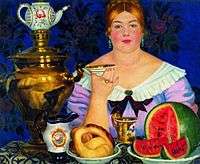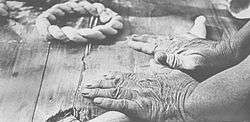Kalach (food)
- For other meanings see kalach.
|
| |
| Type | Sweet bread |
|---|---|
| Place of origin | Ukraine, Russia, Serbia, Bulgaria |
| Main ingredients | Wheat flour |
|
| |
Kalach, kalács, kolach, or colac (Ukrainian: кaлач or колач; Russian: кала́ч; Hungarian: kalács; Romanian: colac; Serbian: колач/kolač, Bulgarian: колач), is a traditional Eastern European bread, commonly served during various ritual meals.[1] The name originates from the Old Slavonic word kolo (коло) meaning "circle", "wheel".
Ukrainian tradition
Ukrainian kolaches are made by braiding dough made with wheat flour into ring-shaped or oblong forms. They are a symbol of luck, prosperity, and good bounty, and are traditionally prepared for Svyat Vechir (Holy Supper), the Ukrainian Christmas Eve ritual, most often in the form of three round bread loaves stacked one atop the other with a candle in the middle.
In the area around Kiev, it was custom for a midwife to give a kolach as a gift to parents, as part of a fertility blessing.[2] Kalaches were also used in funeral ceremonies.[3] As well in Galicia and Bukovina they were given by children to their godparents in ceremony called a kolachyny (кола́чини) or kolachannya (кола́чання).[4]
The Bread Museum in L'viv, Ukraine, contains many examples of intricately woven kalach, paska, and babka.[5]
Russian tradition

The Russian word калач (kalách, kolach) stands for a specific type of twisted white bread. In former times калач meant any kind of white bread, and before modern methods of grinding wheat came into use, white bread was classed as a type of fancy bread.
Cultural legacy
A man who made kalaches was called a калачник (kalachnik), which sometimes by sandhi effect became калашник, and sometimes such a man's descendants thus got the surname Калачник (Kalachnik) or Калашник (Kalashnik), which in Russian became Калашников (Kalashnikov) (= "[son] of the kalach-maker").
Romanian tradition

The traditional Romanian colac is a braided bread, typically made for special occasions or holidays, such as Christmas, Easter, weddings, and funerals.[6] It is a traditional custom of Romanian rural society, on Christmas Eve, to gather in groups, to go in different houses and to sing colinde, traditional Christmas carols. In some villages, they go first to the mayor's house, followed by the teacher's house, whereas in other parts there is no pre-established order. The families would then invite them into the house, and give them different small gifts such as nuts, dried fruits, and colacs.
The word came from Slavic kolač and ultimately from Proto-Slavic kolo ("circle", "wheel") referring to the circular form.[7] The word may be cognate with challah (Hebrew: חלה ḥallah) and Greek ϰολλιξ.
Hungarian tradition
The Hungarian kalács (pronounced [ˈkɒlaːtʃ]) is a sweet bread very similar to brioche, usually baked in a braided form, and traditionally considered an Easter food. Until the end of the 19th century, the preparation of kalács was similar to that of everyday bread; the difference was in the shape, and in the better/quality flour used for the kalács. Nowadays kalács is prepared from dough enriched with milk and eggs.[8] It is is baked in an oven or brick oven, sometimes directly on the stones of the brick oven, or on a baking sheet.
Kalács is part of the traditional Easter menu in Hungary, often consecrated together with ham in Catholic churches. In the Szeged region at All Saints unfilled kalács was baked called All Saints' Kalács (mindenszentek kalácsa, kolduskalács = Beggar's Kalács), which was given to beggars at the gate of the graveyard. Also kalács was given to beggars praying at the graveyard's gate in Csallóköz to prevent the dead from returning.[9] Giving kalács to beggars is the Christian form of the pagan tradition of treating the dead.[10]
See also
References
- ↑ Nokony, Vkka A. (1989). "The Ukrainian Museum of Canada". Material History Bulletin (Spring).
- ↑ Boriak, Olena (2010). "The Midwife in Traditional Ukrainian Culture: Ritual, Folklore". Folklorica.
- ↑ Havryl’iuk, Natalia (2003). "The Structure and Function of Funeral Rituals and Customs in Ukraine". Folklorica. VIII (2).
- ↑ http://ukrlit.org/slovnyk/%D0%BA%D0%BE%D0%BB%D0%B0%D1%87%D0%B8%D0%BD%D0%B8
- ↑ http://www.karpaty.info/en/uk/lv/lw/lviv/museums/hliba/
- ↑ "Colac" (in Romanian). DEX online: Dictionar Explicativ al Limbii Romane (Romanian online dictionary).
- ↑ Colac (in Romanian). DEX online: Dictionar Explicativ al Limbii Romane (Romanian online dictionary). References: Miklosich, Slaw. Elem., 25; Cihac, II, 67; Conev 66
- ↑ Ortutay Gyula (1979). Magyar néprajzi lexikon II. (F–Ka). Budapest: Akadémiai. ISBN 963-05-1287-4. Retrieved 2008-10-04.
- ↑ Paládi-Kovács Attila, ed. (1988). Magyar néprajz. Budapest: Akadémiai Kiadó. ISBN 963-05-4922-0. Retrieved 2008-10-04.
- ↑ Bálint Sándor (2004). Ünnepi kalendárium 2. A Mária-ünnepek és jelesebb napok hazai és közép-európai hagyományvilágából (2008-10-04). Budapest: Neumann Kht. ISBN 963-360-044-8.